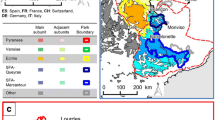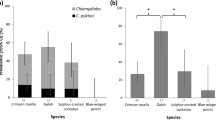Abstract
In 1994, Mycoplasma gallisepticum, a common bacterial poultry pathogen, caused an epidemic in house finches in the eastern part of their North American range where the species had been introduced in the 1940s. Birds with mycoplasmal conjunctivitis were reported across the entire eastern United States within 3–4 years. Here we track the course of the Mycoplasma gallisepticum epidemic as it reached native, western North American populations of the house finch. In 2002, Mycoplasma gallisepticum was first observed in a native house finch population in Missoula, MT, where it gradually increased in prevalence during the next 2 years. Concurrently, house finches with conjunctivitis were reported with increasing number in the Pacific Northwest. In native populations of the host, the epidemic expanded more slowly, and reached lower levels of prevalence than in the eastern, introduced range of the species. Maximal prevalence was about half in the Missoula population than in local populations in the East. Although many factors can contribute to these differences, we argue that it is most likely the higher genetic heterogeneity in western than in eastern populations caused the lower impact of the pathogen.


Similar content being viewed by others
References
Altizer S, Hochachka WM, Dhondt AA (2004) Seasonal dynamics of mycoplasmal conjunctivitis in eastern North American House Finches. Journal of Animal Ecology 73:309–322
Able KP, Belthoff JR (1998) Rapid ‘evolution’ of migratory behaviour in the introduced house finch of eastern North America. Proceedings of the Royal Society, London, Series B 265:2063–2071
Acevedo-Whitehouse K, Gulland F, Greig D, Amos B (2003) Disease susceptibility in California sea lions. Nature 422:35
Badyaev AV, Martin TE (2000) Sexual dimorphism in relation to current selection in the house finch. Evolution 54:987–997
Cherry JJ, Ley DH, Altizer S (2006) Genotypic analyses of Mycoplasma gallisepticum isolates from songbirds by random amplification of polymorphic DNA and amplified-fragment length polymorphism. Journal of Wildlife Diseases 42 (in press)
Coltman DW, Pilkington JG, Smith JA, Pemberton JM (1999) Parasite-mediated selection against inbred Soay sheep in a free-living, island population. Evolution 53:1259–1267
Dhondt AA, Altizer S, Cooch EG, Davis AK, Dobson A, Driscoll MJL, et al. (2005) Dynamics of a novel pathogen in an avian host: mycoplasmal conjunctivitis in house finches. Acta Tropica 94:77–93
Dhondt AA, Tessaglia DL, Slothower RL (1998) Epidemic mycoplasmal conjunctivitis in house finches from eastern North America. Journal of Wildlife Diseases 34:265–280
Duckworth RA, Badyaev AV, Farmer KL, Hill GE, Roberts SR (2003) First case of mycoplasmosis in the native range of the house finch (Carpodacus mexicanus). Auk 120:528–530
Elliott JJ, Arbib S (1953) Origin and status of the house finch in the eastern United States. Auk 70:31–37
Fischer JR, Stallknecht DE, Luttrell MP, Dhondt AA, Converse KA (1997) Mycoplasmal conjunctivitis in wild songbirds: the spread of a new contagious disease in a mobile host population. Emerging Infectious Diseases 3:69–72
Hartup BK, Bickal JM, Dhondt AA, Ley DH, Kollias GV (2001) Dynamics of conjunctivitis and Mycoplasma gallisepticum infections in house finches. Auk 118:327–333
Hartup BK, Stott-Messick B, Guzy M, Ley DH (2004) Health survey of house finches (Carpodacus mexicanus) from Wisconsin. Avian Diseases 48:84–90
Hawley DM, Sydenstricker KV, Kollias GV, Dhondt AA (2005) Genetic diversity predicts pathogen resistance and cell-mediated immunocompetence in house finches. Biology Letters 1:326–329
Hawley DM, Hanley D, Dhondt AA, Lovette IJ (2006) Molecular evidence for a founder effect in invasive house finch (Carpodacus mexicanus) populations experiencing an emergent disease epidemic. Molecular Ecology 15:263–275
Hochachka WM, Dhondt AA (2000) Density-dependent decline of host abundance resulting from a new infectious disease. Proceedings of the National Academy of Sciences of the USA 97:5303–5306
Lepage D, Francis CM (2002) Do feeder counts reliably indicate bird population changes? 21 years of winter bird counts in Ontario, Canada. Condor 104:255–270
Ley DH, Sheaffer DS, Dhondt AA (2006) Further western spread of Mycoplasma gallisepticum infection of house finches. Journal of Wildlife Diseases 42 (in press)
Lively CM, Craddock C, Vrijenhoek RC (1990) Red Queen Hypothesis supported by parasitism in sexual and clonal fish. Nature 344:864–866
MacDougall-Shackleton EA, Derryberry EP, Foufopoulos J, Dobson AP, Hahn TP (2005) Parasite-mediated heterozygote advantage in an outbred songbird population. Biology Letters 1:105–107
McClure HE (1989) Epizootic lesions of house finches in Ventura County, California. Journal of Field Ornithology 60:421–430
Meagher S (1999) Genetic diversity and Capillaria hepatica (Nematoda) prevalence in Michigan deer mouse populations. Evolution 53:1318–1324
Nagatomo H, Takegahara Y, Sonoda T, Yamaguchi A, Uemura R, Hagiwara S, et al. (2001) Comparative studies of the persistence of animal mycoplasmas under different environmental conditions. Veterinary Microbiology 82:223–232
Nolan PM, Hill GE, Stoehr AM (1998) Sex, size, and plumage redness predict house finch survival in an epidemic. Proceedings of the Royal Society, London, Series B 265:961–965
Pearman PB, Garner TWJ (2005) Susceptibility of Italian agile frog populations to an emerging strain of Ranavirus parallels population genetic diversity. Ecology Letters 8:401–408
Pillai SR, Mays HL, Ley DH, Luttrell P, Panangala VS, Farmer KL, et al. (2003) Molecular variability of house finch Mycoplasma gallisepticum isolates as revealed by sequencing and restriction fragment length polymorphism analysis of the pvpA gene. Avian Diseases 47:640–648
Wells JV, Rosenberg KV, Dunn EH, Tessaglia-Hymes DL, Dhondt AA (1998) Feeder counts as indicators of spatial and temporal variation in winter abundance of resident birds. Journal of Field Ornithology 69:577–586
Woolhouse MEJ, Haydon DT, Antia R (2005) Emerging pathogens: the epidemiology and evolution of species jumps. Trends in Ecology and Evolution 20:238–244
Acknowledgments
The authors acknowledge funding from the National Science Foundation (grant no. DEB-0094456) as part of the NIH-NSF Ecology of Infectious Diseases program. A.V.B.’s work in Montana was supported by NSF grants DEB-0075388, IBN-0218313, and DEB-0077804. Any opinions, findings, and conclusions or recommendations expressed in this material are those of the authors and do not necessarily reflect the views of the National Science Foundation. The authors are grateful to the thousands of volunteers who have contributed data to the House Finch Disease Survey and to two anonymous reviewers who provided helpful comments.
Author information
Authors and Affiliations
Corresponding author
Rights and permissions
About this article
Cite this article
Dhondt, A.A., Badyaev, A.V., Dobson, A.P. et al. Dynamics of Mycoplasmal Conjunctivitis in the Native and Introduced Range of the Host. EcoHealth 3, 95–102 (2006). https://doi.org/10.1007/s10393-006-0019-7
Published:
Issue Date:
DOI: https://doi.org/10.1007/s10393-006-0019-7




